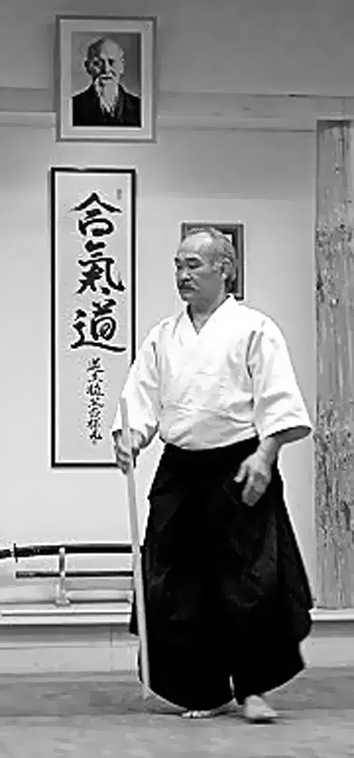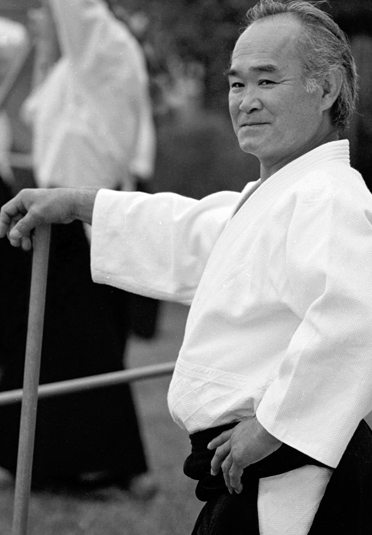Aikidoists Beware
By T.K. Chiba
The martial art (budo) is truly a frightening thing. Although I do not know about the attitudes among the majority of people (especially Aikido-related people), it is necessary to know that the martial art is back-to-back with death. However, the potential death is in an inevitable balance of tension with the instinctive desire to survive. This fact bears itself heavily upon the seeker’s mind and body in the training process, while vividly emphasizing the existential dignity and respect of the lives of the self and others. If we were to find the unchangeable ethic 1n our Japanese budo, its source should be found in the relative balance of tension between life and death and between the self and others.
Aikido is a new way of developing personhood beyond the traditional and conventional martial arts, and it is a combined result of the utmost efforts and natural predispositions of a great personality, Morihei Ueshiba. However, this does not mean that Aikido denies  the various thoughts found in the traditional Japanese budo. In other words, the transcendence of Aikido from the traditional martial arts as a new way of personal development does not mean it ceases to be a martial art, just as it is impossible for humans to stop being human or conversely to assert that their existence bas been non-human. Rather, it may be more appropriate to believe that the Founder’s own internal experience, that is, his spiritual light, was emitted and filtered through the Japanese budo (the rare product of the human race) upon its fundamental and essential existence. I believe that the answer to this process is the Founder’s “take-musu-aiki” (truthful aiki).
the various thoughts found in the traditional Japanese budo. In other words, the transcendence of Aikido from the traditional martial arts as a new way of personal development does not mean it ceases to be a martial art, just as it is impossible for humans to stop being human or conversely to assert that their existence bas been non-human. Rather, it may be more appropriate to believe that the Founder’s own internal experience, that is, his spiritual light, was emitted and filtered through the Japanese budo (the rare product of the human race) upon its fundamental and essential existence. I believe that the answer to this process is the Founder’s “take-musu-aiki” (truthful aiki).
Before Aikido was developed, the concept of aiki had already been in existence in Japanese budo since the ancient times. Likewise, the state that the Founder reached is not exclusively unique to him in the history of Japanese budo. The Founder himself never said that Aikido is not a martial art although he used to say that Aikido is a true budo. I therefore disagree with the view that Aikido is a completely unique and new discipline while ignoring the position of Aikido in the Japanese martial art history and its relative relations with other martial arts.
The fundamental meaning of the impossibility of humans quitting being human is derived from the fact that humans cannot become free from the restriction of life and death or from various sufferings (birth, aging, ailments and death). The uniqueness of Aikido as a way of personal development lies in the departure from the self-limiting formalization and win-lose conceptualization found in the traditional Japanese budo, toward the original, fundamental, and permanent place of existence. I find the reason for the Founder’s calling Aikido the real budo in this fact.
There are cheapening trends not only to be overly ideological but also to be commercialized. I feel the necessity to give warnings here. I consider this to be double deterioration. One side of it is that Aikido, as a Japanese martial technical system, becomes more abstract as time progresses. The other side is that Aikido becomes more financially pragmatic in its existence.
In addition to the above, the dojo as the place for personal training is facing increasing amounts of unnecessary organizational and political pressures. This present state sheds a dark shadow on the development of Aikido which relies on the existence and development of young practitioners with free and unrestricted individualities.
These two elements, coexisting with the hedonism that is pervasive in the present society, need to be overcome daily by the seekers of the true Way.
Discovering the Body
by T.K. Chiba, 8th dan
 Anyone who thinks that putting more hours into training will necessarily result in greater achievement in Aikido, is thinking like a child. Fundamentally, this materialistic attitude does not lead anywhere but to an insoluble problem. No matter how many hours of training we accumulate, we cannot avoid moving, day by day, closer to the grave. Many students think that through training they can make their bodies responsive and controllable, able to be moved however they wish. I do not deny that a responsive body is an important part of learning. However, it is only part of it, a part relative to a greater factor, which is the development of an introspective attitude in training, with a serious eye to self examination. In many ways, positively or negatively, our body is the product of our consciousness, and, in order to discover what that is, close self examination is required within our training. It is not helpful to add more and more information, details, power etc., externally and endlessly, to the ‘too much’ that is already there. Recognition of an imbalance, disharmony, or disorder within one’s system, sensed within the body, as well as between the body and consciousness, is a starting point for growth. One might characterize the development of this recognition as a conversation or dialogue which occurs between one’s body and one’s consciousness. As the dialogue develops, awareness becomes clearer, and one begins to perceive the natural power or potential ability which has, until then, been hidden. Instead of adding an external element to the body, changing the body to fit a desire or will, one simply sees what is already within. More importantly, consciousness itself — the way an individual perceives — begins to change as one discovers the “true” body, as opposed to the body that one changes according to will. The vital, unique element that makes Aikido what it is, is that progress in the art moves in proportion to the discovery of that natural power which, together with an organic, dynamic core, already exists within each individual. It is this true body that helps the body function in harmony as a whole. As one follows the path of Aikido, one progressively, with wonder, and joy, encounters the true self, the hidden, ‘estranged self’, which, with its inexhaustable potential, lies undiscovered by many people who die without knowing that it exists. This passage from Dogen Zenji, founder of Soto Zen, touches upon the subject of my talk this morning in a profound way. “Buddhist practice through the body is more difficult than practice through the mind. Intellectual comprehension in learning through the mind must be united to practice through our body. This unity is called ‘SHINJUTSUNINTAI’, the real body of man. It is the perception of everyday mind, through the phenomenal world. If we harmonize the practice of enlightenment with our body, the entire world will be seen in its true form.” Finally, the discovery of the true body, with its value and beauty, is not to be subject to comparison or to competitive discrimination, but rather stands on its own within each individual. It follows as a natural conclusion that the study of the art of Aikido is and must be non-competitive. Some years back I was fortunate to attend a lecture at Smith College, in Hampshire, Massachusetts, given by a Zen Master from Vietnam. During a question and answer period, a woman stood and asked him what he thought of the meditation system practiced by the Quakers. He answered: “How can you compare the beauty of a cherry flower with that of a rose?”
Anyone who thinks that putting more hours into training will necessarily result in greater achievement in Aikido, is thinking like a child. Fundamentally, this materialistic attitude does not lead anywhere but to an insoluble problem. No matter how many hours of training we accumulate, we cannot avoid moving, day by day, closer to the grave. Many students think that through training they can make their bodies responsive and controllable, able to be moved however they wish. I do not deny that a responsive body is an important part of learning. However, it is only part of it, a part relative to a greater factor, which is the development of an introspective attitude in training, with a serious eye to self examination. In many ways, positively or negatively, our body is the product of our consciousness, and, in order to discover what that is, close self examination is required within our training. It is not helpful to add more and more information, details, power etc., externally and endlessly, to the ‘too much’ that is already there. Recognition of an imbalance, disharmony, or disorder within one’s system, sensed within the body, as well as between the body and consciousness, is a starting point for growth. One might characterize the development of this recognition as a conversation or dialogue which occurs between one’s body and one’s consciousness. As the dialogue develops, awareness becomes clearer, and one begins to perceive the natural power or potential ability which has, until then, been hidden. Instead of adding an external element to the body, changing the body to fit a desire or will, one simply sees what is already within. More importantly, consciousness itself — the way an individual perceives — begins to change as one discovers the “true” body, as opposed to the body that one changes according to will. The vital, unique element that makes Aikido what it is, is that progress in the art moves in proportion to the discovery of that natural power which, together with an organic, dynamic core, already exists within each individual. It is this true body that helps the body function in harmony as a whole. As one follows the path of Aikido, one progressively, with wonder, and joy, encounters the true self, the hidden, ‘estranged self’, which, with its inexhaustable potential, lies undiscovered by many people who die without knowing that it exists. This passage from Dogen Zenji, founder of Soto Zen, touches upon the subject of my talk this morning in a profound way. “Buddhist practice through the body is more difficult than practice through the mind. Intellectual comprehension in learning through the mind must be united to practice through our body. This unity is called ‘SHINJUTSUNINTAI’, the real body of man. It is the perception of everyday mind, through the phenomenal world. If we harmonize the practice of enlightenment with our body, the entire world will be seen in its true form.” Finally, the discovery of the true body, with its value and beauty, is not to be subject to comparison or to competitive discrimination, but rather stands on its own within each individual. It follows as a natural conclusion that the study of the art of Aikido is and must be non-competitive. Some years back I was fortunate to attend a lecture at Smith College, in Hampshire, Massachusetts, given by a Zen Master from Vietnam. During a question and answer period, a woman stood and asked him what he thought of the meditation system practiced by the Quakers. He answered: “How can you compare the beauty of a cherry flower with that of a rose?”

